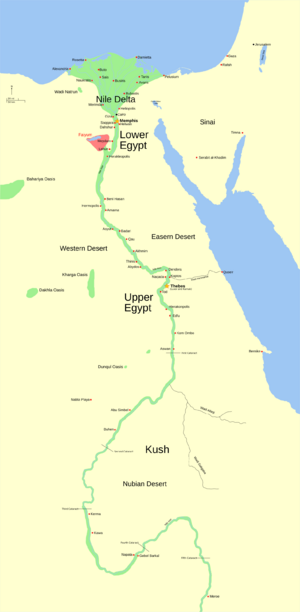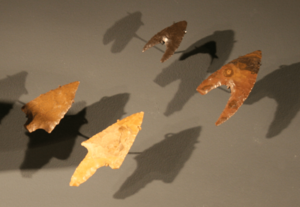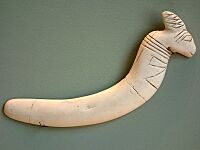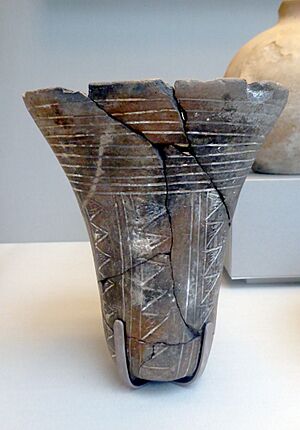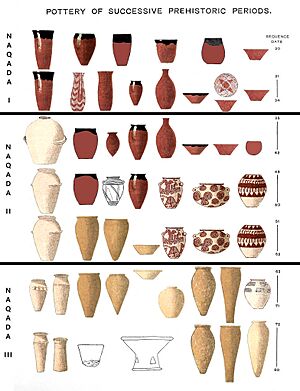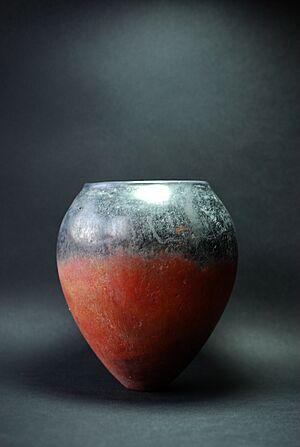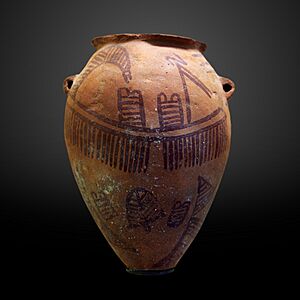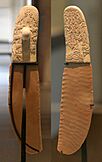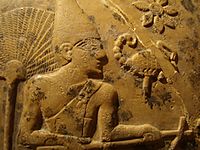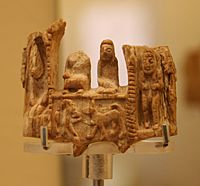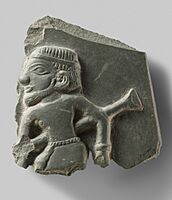Prehistoric Egypt facts for kids
Quick facts for kids
Prehistoric Egypt/
Predynastic Egypt |
|||||||
|---|---|---|---|---|---|---|---|
|
|||||||
Prehistoric Egypt and Predynastic Egypt describe the time in Egypt before it became a unified country. This period started when the first humans settled there and ended around 3100 BC. That's when the First Dynasty of Egypt began.
The "Predynastic Egypt" part usually refers to the end of the Neolithic (New Stone Age). This era lasted from about 6200 BC to 3000 BC. During this time, early Egyptian society slowly developed. Some experts use terms like "Zero Dynasty" for the very end of this period. This is because it was a time of big changes, leading right into the start of the pharaohs' rule.
Archaeologists have found most of their discoveries from this period in Upper Egypt. This is because the Nile River's silt buried many sites in the Delta region (Lower Egypt).
Contents
Ancient Stone Age: Paleolithic Period
Humans have lived in Egypt for a very long time, possibly over two million years! The oldest tools found there are stone tools. Later, people made more advanced tools.
During the later part of the Stone Age, modern humans lived in Egypt. They developed different ways of making tools.
Early Homes in Wadi Halfa
Some of the oldest known buildings were found near Wadi Halfa, close to Sudan. These structures are oval-shaped hollows in the ground. They were about 30 cm deep and 2 by 1 meters wide. Many were lined with flat stones. These stones likely held up dome-shaped shelters made of animal skins or branches. These homes were easy to take apart and move. This allowed hunter-gatherers to live in one place for a while, then move on.
Khormusan Tool Makers
The Khormusan people lived in Egypt between 42,000 and 32,000 years ago. They made tools not only from stone but also from animal bones and a red mineral called hematite. They also created small arrow heads. The Khormusan period ended around 16,000 BC.
Late Paleolithic Discoveries
The Late Paleolithic period in Egypt began around 30,000 BC. A complete human skeleton, called the Nazlet Khater skeleton, was found in 1980. It is about 33,000 years old. This is the only full skeleton of a modern human from this early time in Africa.
Middle Stone Age: Mesolithic Period
Halfan and Kubbaniyan Cultures
The Halfan and Kubbaniyan cultures lived along the Upper Nile Valley. Halfan sites are in northern Sudan, and Kubbaniyan sites are in Upper Egypt. These people ate large herd animals and also fished. They stayed in places for longer periods, suggesting they were not always moving. The Halfan culture came from the Khormusan culture.
Sebilian Grain Gatherers
The Sebilian culture existed from about 13,000 BC to 10,000 BC. In Egypt, pollen found at old sites shows that Sebilian people gathered grains. However, they did not plant domesticated seeds. Some experts think that living in one place to gather grains led to more fighting. This fighting might have ended this period.
Qadan Culture and Early Farming Tools
The Qadan culture (13,000–9,000 BC) was a Mesolithic group in Upper Egypt. They lived by hunting and gathering wild grasses and grains. The Qadan people made efforts to water and harvest local plants. But they did not plant grains in neat rows like farmers do today.
About twenty sites in Upper Nubia show evidence of the Qadan culture's grain-grinding. These people also harvested wild grain along the Nile. This happened when the Sahara desert became drier, forcing people to move closer to the Nile. The Jebel Sahaba cemetery, a Mesolithic burial site, belongs to the Qadan culture.
Qadan people were the first to create sickles. They also developed grinding stones to prepare plant foods. However, these tools were not used after 10,000 BC, when hunter-gatherers replaced them.
Harifian Nomads
The Harifian people (8,800 – 8,000 BC) are thought to have moved from the Fayyum and eastern deserts of Egypt. They joined with another culture called the Pre-Pottery Neolithic B (PPNB). This mix led to a group of cultures that invented nomadic pastoralism, which means moving around with herds of animals.
New Stone Age to Early Dynastic Period
Lower Egypt's Early Settlements
Faiyum A Culture and Agriculture
As the desert grew, early Egyptians had to settle more permanently around the Nile. They began to live a more settled life during the Neolithic period.
From 9000 to 6000 BC, there is not much archaeological evidence. But around 6200 BC, Neolithic settlements appeared across Egypt. Some studies suggest that people from the Fertile Crescent in the Near East brought agriculture to Egypt.
However, some experts disagree. They believe that ancient Egyptians were the same people as those in Nubia and the Sahara. They think some groups from Arabia, the Levant, and North Africa later joined them.
Weaving first appeared during the Faiyum A Period. Unlike later Egyptians, these people buried their dead very close to, or even inside, their homes.
Merimde Culture: Early Villages
From about 5000 to 4200 BC, the Merimde culture thrived in Lower Egypt. This culture is known from a large settlement called Merimde Beni Salama. People lived in small huts and made simple, plain pottery. They raised cattle, sheep, goats, and pigs. They also grew wheat, sorghum, and barley. The Merimde people buried their dead within their settlement. They also made clay figurines. The first life-sized Egyptian head made of clay comes from Merimde.
El Omari Culture
The El Omari culture is known from a small settlement near modern Cairo. People likely lived in huts, but only holes for posts and pits remain. Their pottery was plain. Their stone tools included small flakes, axes, and sickles. They did not yet know how to use metal. Their sites were used from 4000 BC until the Archaic Period (3100 BC).
Maadi Culture: Trade and Technology

The Maadi culture (4000–3500 BC) was a very important culture in Lower Egypt. It existed at the same time as the Naqada I and II cultures in Upper Egypt. This culture showed advances in building and technology. They continued to make plain pottery.
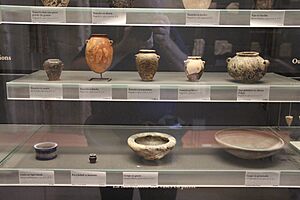
People knew about copper, and some copper tools have been found. Their pottery was handmade and simple. The presence of black-topped red pots shows they had contact with the Naqada sites in the south. Many imported pots from Palestine were also found. They also used black basalt stone vessels.
People lived in small huts, some dug partly into the ground. The dead were buried in cemeteries, but with few items buried with them. The Naqada III culture later replaced the Maadi culture. We don't know if this happened through war or by people slowly moving in.
Gallery
Upper Egypt's Early Cultures
Tasian Culture: Early Pottery
The Tasian culture appeared around 4500 BC in Upper Egypt. This group is named after burials found at Der Tasa. The Tasian culture is known for making the earliest "blacktop-ware." This is a type of red and brown pottery that is black on the top and inside. This pottery helps archaeologists date Predynastic Egypt.
Because dating this period is hard, WMF Petrie created a system called sequence dating. This system uses pottery styles to figure out the relative age of a site. As the Predynastic period went on, pottery handles changed from useful to decorative. This also helps in dating sites.
The Tasian and Badarian cultures were very similar and overlapped. It seems that Upper Egypt was strongly influenced by Lower Egypt's culture from this time onward.
Badarian Culture: Copper and Faience
The Badarian culture, from about 4400 to 4000 BC, is named after the Badari site. It followed the Tasian culture and was very similar. Many consider them one continuous period. The Badarian culture continued to make blacktop-ware, but it was much better quality. The main difference is that Badarian sites used copper as well as stone. This means they were Chalcolithic (Copper Age) settlements. The Tasian sites were still Neolithic (Stone Age).
Badarian flint tools became sharper and more shaped. The first faience (a type of glazed ceramic) was also developed. Badarian sites have been found from Nekhen to just north of Abydos.
Naqada Culture: A Flourishing Period
The Naqada culture is an important archaeological culture of Chalcolithic Predynastic Egypt (c. 4000–3000 BC). It is named after the town of Naqada. This culture is divided into three parts: Naqada I, II, and III. Studies of skeletons from Naqada show they were similar to people from Northeast Africa.
Amratian Culture (Naqada I)
The Amratian culture lasted from about 4000 to 3500 BC. It is named after the site of El-Amra. This period is also called Naqada I. Black-topped pottery continued to be made. A new type of pottery, called white cross-line ware, also appeared. This pottery had white lines crossing each other.
New discoveries show more trade between Upper and Lower Egypt during this time. A stone vase from the north was found at el-Amra. Copper, which is not found in Egypt, was brought in from the Sinai or Nubia. Obsidian and a small amount of gold definitely came from Nubia. Trade with oases (desert fertile spots) was also likely.
Early forms of later Egyptian buildings appeared in Amratian settlements. For example, mud-brick buildings, which became common later, were first seen in small numbers.
Gerzean Culture (Naqada II)
The Gerzean culture, from about 3500 to 3200 BC, is named after the site of Gerzeh. This was a very important stage in Egyptian development. It laid the groundwork for Dynastic Egypt. The Gerzean culture grew out of the Amratian culture. It started in the delta and moved south through Upper Egypt.
Gerzean pottery was painted mostly in dark red. It showed pictures of animals, people, ships, and geometric shapes. Handles on pottery became more common and decorative.
During this time, rainfall decreased a lot. Farming along the Nile became the main way to get food. People started living in one place more, and cities grew to about 5,000 people.
Egyptian city dwellers stopped building with reeds. They began making many mud bricks, first seen in the Amratian Period, to build their cities.
Copper was used for all kinds of tools, and the first copper weapons appeared. Silver, gold, lapis lazuli, and faience were used for decorations. Grinding palettes, used for eye-paint, began to have carvings.
The first tombs in the classic Egyptian style were also built. They looked like ordinary houses and sometimes had several rooms.
Foreign objects and art forms appeared in Egypt during the Gerzean period. This shows that Egypt had contact with parts of Asia. Objects like the Gebel el-Arak knife handle have carvings that look Mesopotamian. Silver found from this period could only have come from Asia Minor.
Also, Egyptian objects were made to look like Mesopotamian forms. Cylinder seals appeared in Egypt. The ceremonial mace heads from this time were shaped like Mesopotamian ones.
The trade route is hard to know for sure. It was likely over water, perhaps through middlemen from Byblos. Many Gerzean sites are near the mouths of dry riverbeds (wadis) that lead to the Red Sea. This might mean some trade happened through the Red Sea.
Even with this foreign influence, experts agree that the Gerzean Culture was mostly Egyptian.
Protodynastic Period (Naqada III)
The Naqada III period, from about 3200 to 3000 BC, is also called the Protodynastic period. This was the time when Egypt became a unified country.
Naqada III is important for several reasons:
- It was the first era with hieroglyphs (though some debate this).
- It saw the first regular use of serekhs (early royal symbols).
- It had the first irrigation systems.
- The first royal cemeteries appeared.
The modern Cairo suburb of Maadi is built over the original Naqada stronghold.
-
The Scorpion Macehead, Ashmolean Museum.
Lower Nubia: Nabta Playa
Lower Nubia is in modern-day Egypt, but it was south of ancient Egypt's border.
Nabta Playa: Early Astronomy
Nabta Playa was once a large basin in the Nubian Desert. It is about 800 kilometers south of modern Cairo. Today, many archaeological sites are found there. The Nabta Playa site, one of the earliest Neolithic sites in Egypt, dates to about 7500 BC.
Excavations at Nabta Playa suggest that people from both Sub-Saharan Africa and the Mediterranean area lived there. The people of the wider Nabta Playa region likely spoke a Nilo-Saharan language.
Timeline of Prehistoric Egypt
- Late Paleolithic (from 40,000 BC)
- Aterian tool-making.
- Semi-permanent homes in Wadi Halfa.
- Tools made from animal bones, hematite, and other stones.
- Neolithic (from 11,000 BC)
- c. 10,500 BC: Wild grain harvesting along the Nile. Early stone sickle blades were created.
- c. 8000 BC: People moved to the Nile. They developed a more organized society and settled farming.
- c. 7500 BC: Animals were brought from Asia to the Sahara.
- c. 7000 BC: Farming (animals and grains) in East Sahara.
- c. 7000 BC: In Nabta Playa, deep water wells were dug. Large, planned settlements were built.
- c. 6000 BC: Simple boats (rowed, single-sailed) shown in Egyptian rock art.
- c. 5500 BC: Stone-roofed underground rooms in Nabta Playa. These contained buried sacrificed cattle.
- c. 5000 BC: An ancient stone circle (megalith) in Nabta Playa, possibly for astronomy.
- c. 5000 BC: Badarian period: furniture, tableware, models of houses, pots, figurines, combs.
- c. 4400 BC: A finely-woven linen fabric fragment was found.
- From 4th Millennium BC (Inventions become common)
- c. 4000 BC: Early Naqadan trade began.
- 4th millennium BC: Gerzean tomb-building, with underground rooms and burial items.
- 4th millennium BC: Cedar wood imported from Lebanon.
- c. 3900 BC: The Sahara became drier, causing people to move to the Nile Valley.
- c. 3500 BC: Lapis lazuli stone imported from Badakshan and/or Mesopotamia.
- c. 3500 BC: Senet, one of the world's oldest confirmed board games.
- c. 3500 BC: Faience, the earliest-known glazed ceramic beads.
- c. 3400 BC: Cosmetics, donkey domestication, iron tools (from meteorites), mortar (masonry) used.
- c. 3300 BC: Double reed instruments and lyres (early musical instruments).
- c. 3100 BC: Pharaoh Narmer, or Menes, or possibly Hor-Aha united Upper and Lower Egypt.
See also



